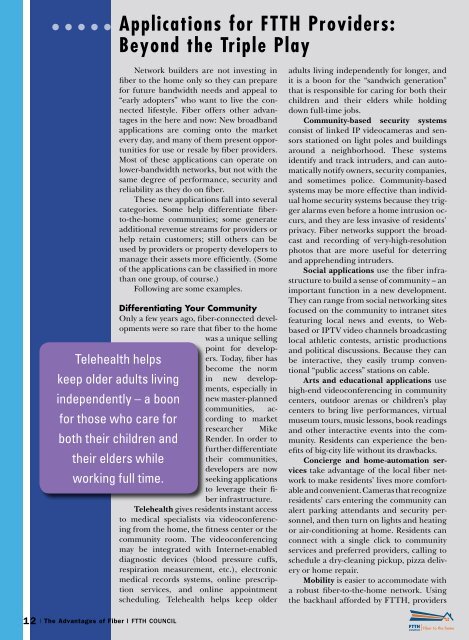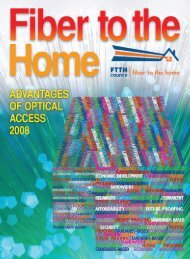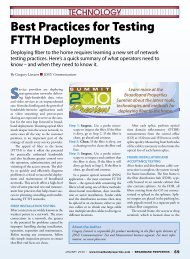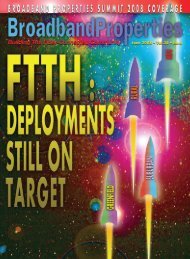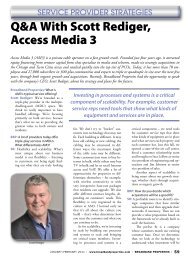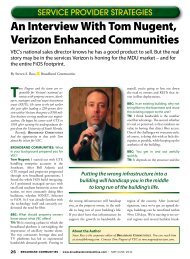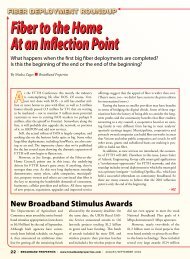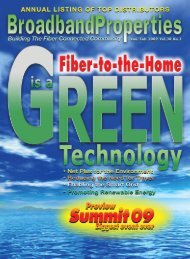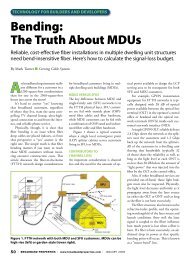Download - Broadband Properties
Download - Broadband Properties
Download - Broadband Properties
You also want an ePaper? Increase the reach of your titles
YUMPU automatically turns print PDFs into web optimized ePapers that Google loves.
Applications for FTTH Providers:<br />
Beyond the Triple Play<br />
Network builders are not investing in<br />
fiber to the home only so they can prepare<br />
for future bandwidth needs and appeal to<br />
“early adopters” who want to live the connected<br />
lifestyle. Fiber offers other advantages<br />
in the here and now: New broadband<br />
applications are coming onto the market<br />
every day, and many of them present opportunities<br />
for use or resale by fiber providers.<br />
Most of these applications can operate on<br />
lower-bandwidth networks, but not with the<br />
same degree of performance, security and<br />
reliability as they do on fiber.<br />
These new applications fall into several<br />
categories. Some help differentiate fiberto-the-home<br />
communities; some generate<br />
additional revenue streams for providers or<br />
help retain customers; still others can be<br />
used by providers or property developers to<br />
manage their assets more efficiently. (Some<br />
of the applications can be classified in more<br />
than one group, of course.)<br />
Following are some examples.<br />
Differentiating Your Community<br />
Only a few years ago, fiber-connected developments<br />
were so rare that fiber to the home<br />
was a unique selling<br />
point for developers.<br />
Today, fiber has<br />
become the norm<br />
in new developments,<br />
especially in<br />
new master-planned<br />
communities, according<br />
to market<br />
researcher Mike<br />
Render. In order to<br />
further differentiate<br />
their communities,<br />
developers are now<br />
seeking applications<br />
to leverage their fiber<br />
infrastructure.<br />
Telehealth gives residents in stant access<br />
to medical specialists via videoconferencing<br />
from the home, the fitness center or the<br />
community room. The videoconferencing<br />
may be integrated with Internet-enabled<br />
diagnostic devices (blood pressure cuffs,<br />
respiration measurement, etc.), electronic<br />
medical records systems, online prescription<br />
services, and online appointment<br />
scheduling. Telehealth helps keep older<br />
Telehealth helps<br />
keep older adults living<br />
independently – a boon<br />
for those who care for<br />
both their children and<br />
their elders while<br />
working full time.<br />
adults living independently for longer, and<br />
it is a boon for the “sandwich generation”<br />
that is responsible for caring for both their<br />
children and their elders while holding<br />
down full-time jobs.<br />
Community-based security systems<br />
consist of linked IP videocameras and sensors<br />
stationed on light poles and buildings<br />
around a neighborhood. These systems<br />
identify and track intruders, and can automatically<br />
notify owners, security companies,<br />
and sometimes police. Community-based<br />
systems may be more effective than individual<br />
home security systems because they trigger<br />
alarms even before a home intrusion occurs,<br />
and they are less invasive of residents’<br />
privacy. Fiber networks support the broadcast<br />
and recording of very-high-resolution<br />
photos that are more useful for deterring<br />
and apprehending intruders.<br />
Social applications use the fiber infrastructure<br />
to build a sense of community – an<br />
important function in a new development.<br />
They can range from social networking sites<br />
focused on the community to intranet sites<br />
featuring local news and events, to Webbased<br />
or IPTV video channels broadcasting<br />
local athletic contests, artistic productions<br />
and political discussions. Because they can<br />
be interactive, they easily trump conventional<br />
“public access” stations on cable.<br />
Arts and educational applications use<br />
high-end videoconferencing in community<br />
centers, outdoor arenas or children’s play<br />
centers to bring live performances, virtual<br />
museum tours, music lessons, book readings<br />
and other interactive events into the community.<br />
Residents can experience the benefits<br />
of big-city life without its drawbacks.<br />
Concierge and home-automation services<br />
take advantage of the local fiber network<br />
to make residents’ lives more comfortable<br />
and convenient. Cameras that recognize<br />
residents’ cars entering the community can<br />
alert parking attendants and security personnel,<br />
and then turn on lights and heating<br />
or air-conditioning at home. Residents can<br />
connect with a single click to community<br />
services and preferred providers, calling to<br />
schedule a dry-cleaning pickup, pizza delivery<br />
or home repair.<br />
Mobility is easier to accommodate with<br />
a robust fiber-to-the-home network. Using<br />
the backhaul afforded by FTTH, providers<br />
12 | The Advantages of Fiber | FTTH Council


